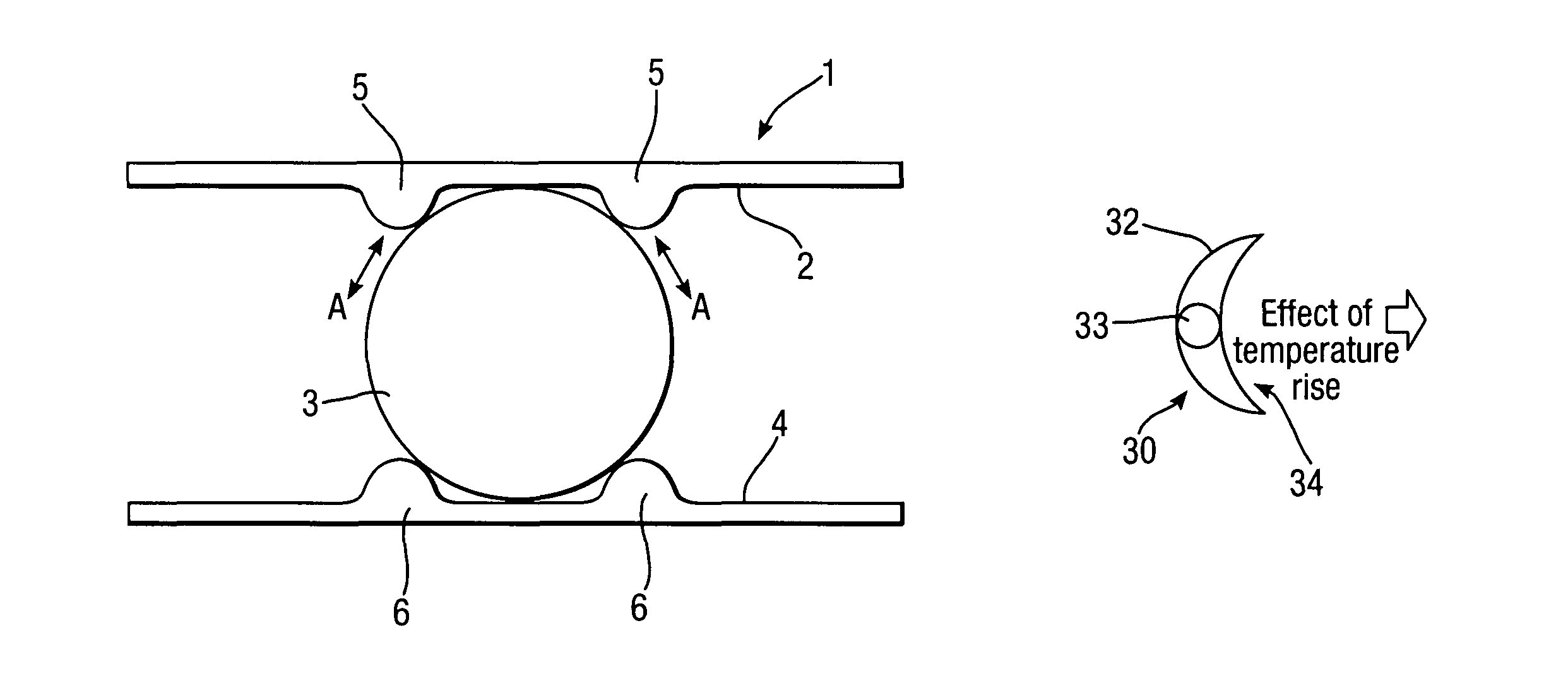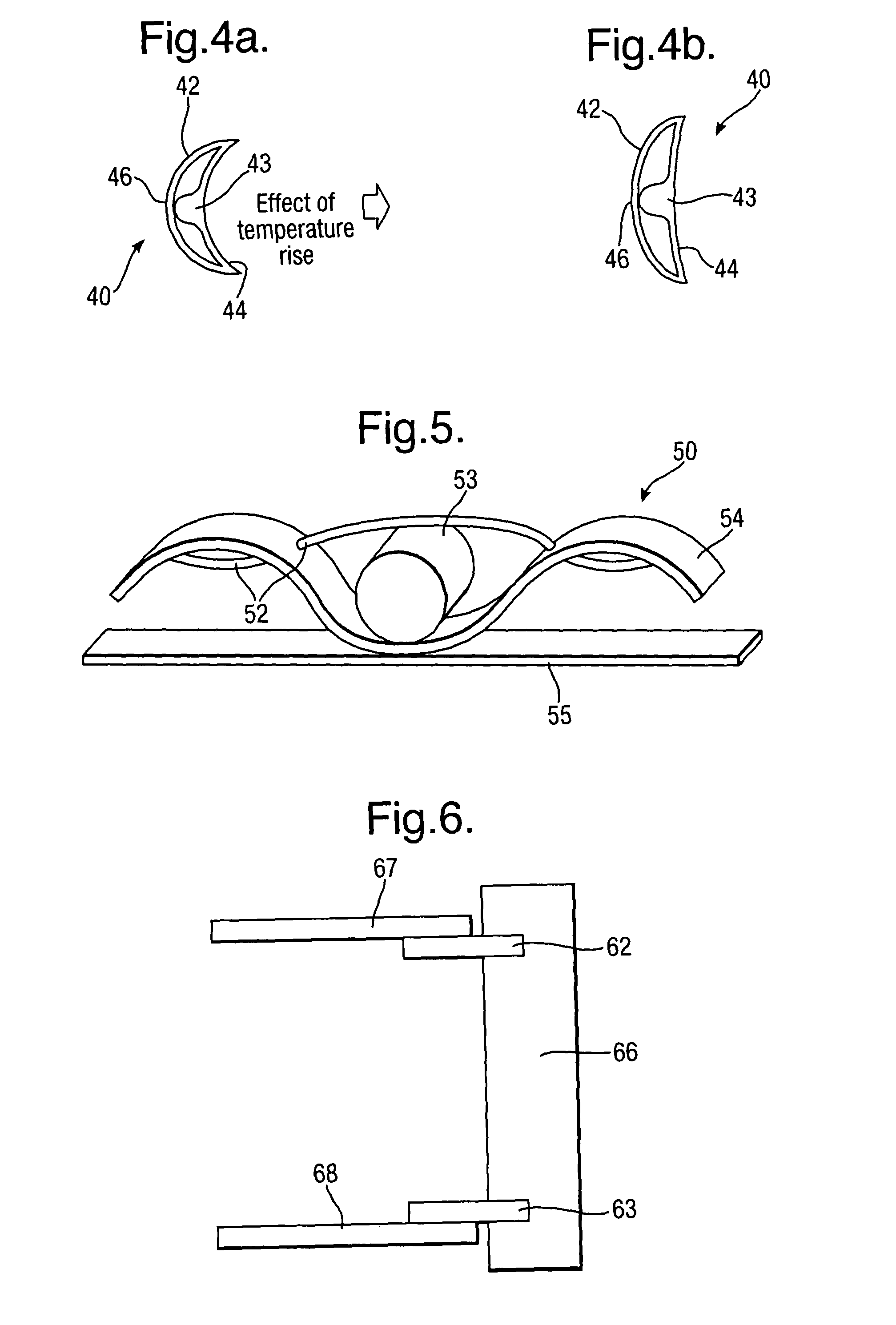Actuator
a technology of actuators and actuators, applied in the field of actuators, can solve the problems of limiting the potential of shape memory material deformation to be used, and reducing the efficiency of actuation,
- Summary
- Abstract
- Description
- Claims
- Application Information
AI Technical Summary
Benefits of technology
Problems solved by technology
Method used
Image
Examples
second embodiment
[0041]FIG. 2 provides a schematic cross section of a second actuator 11 in accordance with aspects of the present invention. In this second embodiment of an actuator 11 a flat shape memory alloy layer 12 slides relative to a pedestal portion 13 extending from a spring material layer 14. It will be understood that the pedestal is formed with an appropriate fillet radii 15 and central section in the form of a bulbous end 16 such that the pedestal 13 is appropriately presented and the bulbous end 16 allows bending of the shape memory alloy layer 12 thereabouts. Again, the shape memory alloy material will slide in the direction of arrowheads B such that spacing between the shape memory alloy layer 12 and the presenting spring material layer 14 is retained whilst thermal contact, as well as constraint of the layer 12, is limited.
[0042]The second embodiment depicted in FIG. 2 can be considered a rocker pedestal arrangement in view of the necessary bulbous end or other rounded aspects to t...
third embodiment
[0060]FIG. 5 illustrates an actuator in accordance with aspects of the present invention. This actuator 50 comprises a shape memory alloy fibre or fibre bundle 52 interleaved with a bias in the form of a corrugated spring 54 with a spacer 53 in the form of a roller. The roller 53 will generally incorporate notches or grooves to guide and present the shape memory alloy fibre or wire 52. In such circumstances, the shape memory alloy wire and bias spring 54 are in an antagonistic relationship such that expansion or contraction of the shape memory alloy fibre 52 causes alterations in the configuration of the actuator whilst the spring 54 returns the actuator to a base state dependent upon the shape memory alloy condition. Optionally, a stiffening surface 55 may be added to provide a mounting for the actuator arrangement.
[0061]In use the shape memory alloy fibre or cable 52 may be attached to a device which requires actuation. In such circumstances, dependent upon the thermal cycle, the ...
fifth embodiment
[0066]FIGS. 8 and 9 respectively illustrate use of an actuator in accordance with aspects of the present invention located within the trailing edge of a blade or vane of a gas turbine engine. FIG. 8 illustrates schematically a cross section such that an actuator 71 is located towards a trailing edge of the blade 70. The actuator 71 comprises a bimetallic titanium / shape memory alloy located appropriately in order to alter and deform over a temperature cycle. Typically, an additional length 72 of the actuator is provided to generate more force with respect to the shape memory alloy. An opposed surface 73 has a lower stiffness projecting to an air washed surface 74. In such circumstances, rollers or other slide elements 75 are provided within the actuator 71 in order that the shape memory alloy deforms over its thermal range, the rollers or other slide elements provide necessary deformation of the trailing edge of the blade 70 whilst avoiding stress differentiation across the actuator ...
PUM
| Property | Measurement | Unit |
|---|---|---|
| transition temperatures | aaaaa | aaaaa |
| depth | aaaaa | aaaaa |
| depth | aaaaa | aaaaa |
Abstract
Description
Claims
Application Information
 Login to View More
Login to View More - R&D
- Intellectual Property
- Life Sciences
- Materials
- Tech Scout
- Unparalleled Data Quality
- Higher Quality Content
- 60% Fewer Hallucinations
Browse by: Latest US Patents, China's latest patents, Technical Efficacy Thesaurus, Application Domain, Technology Topic, Popular Technical Reports.
© 2025 PatSnap. All rights reserved.Legal|Privacy policy|Modern Slavery Act Transparency Statement|Sitemap|About US| Contact US: help@patsnap.com



